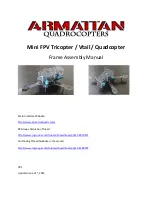
16
Signal Loss Protection function
If the radio link is interrupted while the model is in the air - e.g. the
copter flies beyond the range of the radio control system, the trans-
mitter fails, interference affects the signal, etc. - the model takes up
a stable hover at a height of about 2 - 3 m for about five seconds
before descending automatically to a landing.
Conventional flight mode and intelligent flight mode
Until now the direction of flight of radio-controlled models was
always fixed, i.e. forward was always forward, and back was al-
ways back. The drawback to a fixed direction of flight is that the
pilot has to re-think his commands when, for example, the model
is flying towards him. In this case the pilot gives a command to
turn right or left, but the model now moves in exactly the opposite
direction relative to him. This "conventional flight mode" is very
difficult to master, especially for the beginner. The situation is
even worse with quadrocopters, as their layout makes it even
harder to detect which side of the model is forward, back, right
and left. That is why we have incorporated an "intelligent control
mode" in the GALAXY VISITOR 3. If the machine is operated in
this control mode, forward on the model does not always equate
to the forward direction of flight. This means that the model al-
ways flies towards the pilot if he moves the pitch-axis stick toward
himself. It makes no difference where the actual front face of the
quadrocopter is pointing.
CAUTION:
when you operate the copter in intelligent flight mode,
the transmitter aerial should always face the model, as this flight
mode works best in this situation.
Switching between the two flight modes
First switch the radio control transmitter on, then connect the re-
ceiver power supply in the GALAXY VISITOR 3. Hold the AUX 1
button pressed in for about three seconds, and do not release it
until the Status LED starts flashing slowly. This method can be
used at any time to switch between the two flight modes. If you
are a beginner, we recommend that you set the mode on the
ground, and do not change it in flight, otherwise you could lose
control of the model.
Conventional flight mode
The Status LED glows constantly red when the GALAXY VISI-
TOR 3 is operated in conventional flight mode. In this mode "for-
ward on the model" is always "the forward flight direction".
Intelligent flight mode
The Status LED flashes slowly red when the GALAXY VISITOR 3 is
operated in intelligent flight mode. In this mode "forward on the mo-
del" is always the side which faces away from the transmitter.
CAUTION:
when the model takes off, the transmitter aerial
must always face the Status LED. If you neglect this, you
may find that the control directions are not correct.
Operating Instructions - GALAXY VISITOR 3 RTF FTR 2.4 GHz No. NE2529M2
No. NE2529M1




































